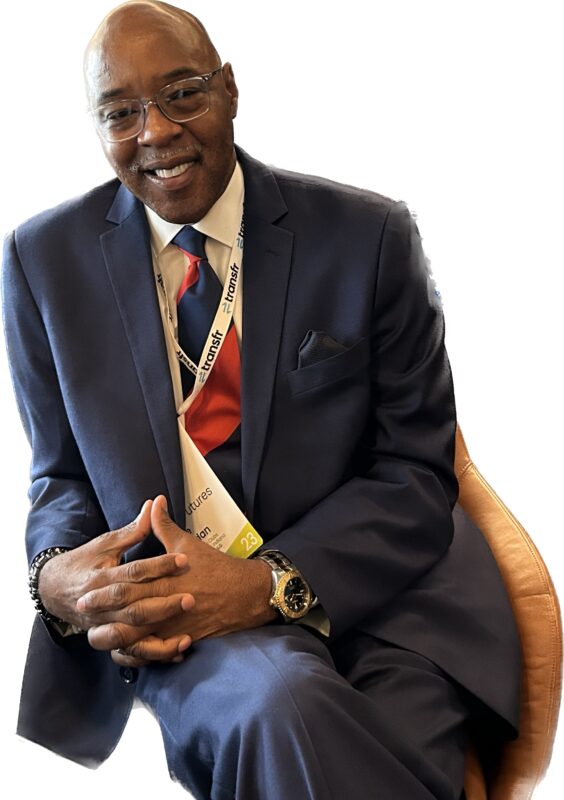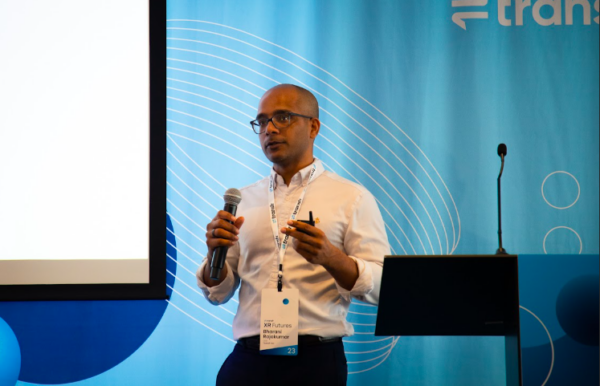AI isn’t the only acronym poised to create vast improvements in the way we teach and learn. Last month, eSchool attended “XR Training: The Next Frontier of Learning,” hosted by Transfr Inc. The event featured many speakers including CEO Bharani Rajakumar (pictured above), developers, and users in the corporate, not-for-profit, and government sectors that use simulation software to enhance job training programs.
Conversations touched on a wide variety of topics from the distinctions of spatial computing, to how XR can reduce the skills gap, to how its application can become a powerful force in underserved communities. It was a great opportunity to listen to some of the leading experts in the field, get our chance to try the gear firsthand and hear how the tech is already impacting lives. Scroll down for some highlights of the sessions and some examples of the simulations in action.
Extended reality (XR) is considered a catch-all term for augmented, virtual, and mixed reality technologies. The technology intends to combine or mirror the physical world with a “digital twin world” able to interact with it, which gives users an immersive experience by being in a virtual or augmented environment.
According to the US Bureau of Labor Statistics and the US Census Bureau, around 11 million people are either looking for a job or would look for one if they had the necessary skills. Transfr focuses on areas like construction, manufacturing, and healthcare, where almost 4 million job opportunities exist that don’t require a 4-year degree. The company believes in allowing everyone to pursue upward mobility by learning about their interests and acquiring the necessary skills.
The company has created over 300 training simulations, offering immersive experiences in aviation maintenance, diesel technology, and, more recently, healthcare. The introduction of Career Exploration 2.0 allows students to explore various career options through shorter, more engaging simulations, including new modules in health sciences and future occupations like electric vehicles and semiconductors. The platform has seen significant developments, including a new VR application for Career Exploration 2.0 with login options, diverse virtual coaches, multi-language support (including Spanish in 2024), closed captioning, and an enhanced dashboard for easier classroom management. Transfr has also launched a Career Exploration dashboard that helps instructors track students’ exploration paths and preferences, facilitating better guidance.
You can check out some of their simulation examples below:

The cutting-edge technology has implications beyond just improving job training. I had the opportunity to chat with Joe Jordan, the President and CEO of the Boys and Girls Clubs of Northeast Indiana, about how XR simulation training can help close the skills gap.
He envisions XR technology becoming an essential project within his organization, fostering economic development and providing essential skills for youth. The collaboration with Transfer is seen as a win-win proposition, aligning technology companies with educational institutions to create solutions for the benefit of the community.
The Boys and Girls Club’s partnership with Transfer demonstrates a holistic approach to child development, leveraging technology to bridge educational gaps, create opportunities, and contribute to economic development, all while emphasizing the importance of strategic partnerships. Have a listen:
- Meet the Winners—Dr. Kellie Wilks, Chief Technology Officer, of Ector County Independent School District, TX (ECISD) - April 12, 2024
- Meet the Winners—Prince William County Public Schools (PWCS) in Manassas, Virginia wins the 2024 Community Leadership Award for Digital Equity. - April 12, 2024
- #CoSN2024 Conversation – Tom Ryan Co-Founder K-12 Strategic Technology Advisor Group (NM) - April 10, 2024

